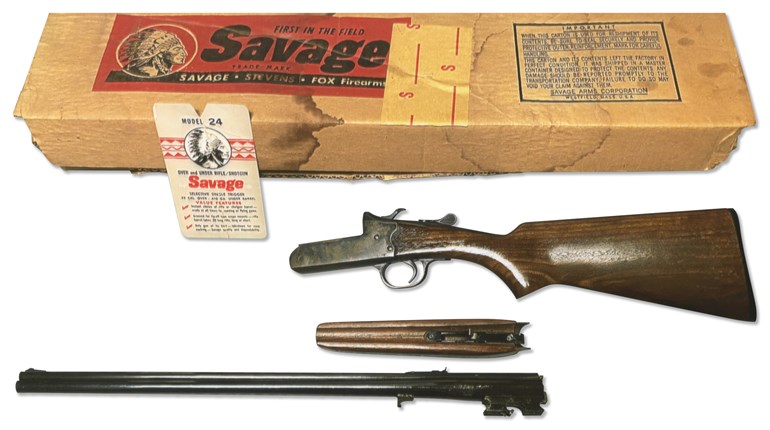
I once did a “study” of all the rifle actions to see which was the fastest when hitting the target was important. I set up a life-size deer target and developed a scoring system. I gathered up half a dozen shooters of various abilities, cases of ammo and two rifles for each action type.
I was certain the semi-automatic would win—since it requires the least amount of effort from the shooter—but when the smoke cleared three days and hundreds of rounds later, the straight-pull, bolt-action squeaked out a victory. The single-shot, as expected, was dead last. Surprisingly, the lever action was second to last. Third, in an upset, went to the bolt action. I have no doubt that a highly trained shooter with a semi-auto rifle would have won, but to a man we fell into the trap of shooting too fast and neglecting to actually aim.
Straight-pull, centerfire rifles go back to the Mannlicher Model 1886. Americans had our first straight-pull in 1895 with the Lee-Navy rifle. Today, the modern, straight-pull design is hugely popular in Europe and barely known in the U.S. Browning offered the Acera in America for a brief while, but I am not sure any actually made it to market. For the most part, if American shooters want a straight-pull, they must shell out some pretty big bucks for a European rifle.

Why a straight pull? Speed. Have you ever watched Olympic biathlon shooters and wondered how they were working the bolt so fast? It’s because they are using a straight-pull, bolt-action. With the rimfire version, it’s a flip of the fingers and the gun is cycled. With practice, the centerfire rifles are almost as fast. Also, as my test showed, the straight pull adds a bit of practical accuracy by driving the gun and the shooter’s focus to the target.
I have been fortunate enough to have shot and hunted with straight-pull rifles quite a bit. At one point I held the record for the fastest time in the “Crazy Buffalo” stage of the safari-prep school at FTW Ranch. (I may still, as far as I know.) I did it with a Blaser R8 in .458 Lott.
In Hungary, I had a very large and quite angry wild boar that tried to get into my personal space. It ended when I shot him so close that he sprayed snow on my pants as he slid to a stop. In Alaska, I picked a fight with a brown bear that ended several shots later and with less than 10 yards between us.
Whitetail, boar, zebra, oryx, wildebeest, impala, warthog, bear; the list is long of the animals I have hunted with a straight-pull rifle. Add in several running-boar shoots and an extensive test with tactical, straight-pull rifles and I have enough trigger time with the straight-pull design to claim I am a fan, which puts me into a rather small group of shooters in America. I have wondered for years why no gun company has made a serious attempt at the centerfire, straight-pull market here.

All that changed recently when Savage introduced its Impulse line of straight-pull, bolt-action rifles with an MSRP that’s a fraction of most European rifles. The early introduction is pointed mostly at the hunting market, but I see a lot of tactical potential for these rifles.
Initially, three rifles were introduced: the Hog Hunter, the Big Game and the Predator. The difference between the three is mostly cosmetic and in the chamberings offered. The exception is the Predator, which uses an AICS removable-box, 10-round magazine rather than the flush-fit, four-round magazine the other two use.
The various rifles are offered in chamberings from .22-250 Rem. through .300 Win. Mag., with most of the usual suspects in between. We asked to sample a couple of .308 Win. rifles, but they arrived in 6.5 Creedmoor, which just reinforces my belief that there is some dark cartel in charge that says guns writers are only allowed to review rifles in 6.5 Creedmoor, now and forever.
The receiver is aluminum with a steel insert at the rear to buff up the wear points. Internally, the action is a cylinder that accepts the round bolt. The receiver is fitted with an integral 20-MOA rail on top that will take Weaver or Picatinny rings. The bolt stop is inside the steel insert and to release the bolt you push it forward and in.
Fitted to the barrel is a hardened-steel extension, which has a half-circle ring cut inside to accommodate the ball bearings in the bolt. The extension is fitted to the barrel with the conventional Savage-style barrel nut and captures the recoil lug. The extension fits tightly into the front of the action and is locked in place by four screws that clamp a buttress along the bottom of the action. The front screw fits into a rounded insert that slides into a half-round cut in the barrel extension to position and orient the barrel correctly.
When the gun is in battery, the bolt fits into the barrel extension and a spring-loaded plunger comes forward, forcing six evenly spaced ball bearings out of the bolt head to fill the half-round recess cut into the barrel extension. These ball bearings lock the action shut, replacing the traditional bolt lugs. The floating bolt head that contains the ball bearings has a fixed-position extractor held in place with a clip ring that circles much of the bolt. On the rifles I had, this extractor was stiff with little movement—which probably accounted for the ejection issues noted later on. The ejector is a fixed position, spring-loaded, standing-style fitted to the rear of the action and rotates on a center screw. It fits into a slot in the bolt and like all standing ejectors, the force applied to the brass for ejection is controlled by the speed of the bolt when the cartridge hits the ejector.
To work the action, pull the bolt handle back, causing it to rotate on its stem at the top and pull back the plunger that pushes the ball bearings into lockup to unlock the action. The plunger is now locked back until the bolt is closed again. This rotating bolt also will activate an internal cam, which handles re-cocking.
When the bolt closes, the back of the receiver contacts the locking wedge holding the plunger and releases it to go forward and push the ball bearings into place. This lock is on a sliding piece that fits against the back of the receiver. After firing, this piece will move forward with the bolt rotation and push against the action to help with initial extraction.

The bolt can be unlocked and opened in the cocked position by pushing on a release button on the rear of the bolt. This allows unloading with the tang-mounted, two-position safety in the safe position.
The bolt handle can easily be swapped to left-hand use. It’s also adjustable for position by removing it and inserting the splined section into one of the key positions. The large, bolt-handle knob is threaded 5/16x24 to allow easy replacement with an aftermarket knob. Savage says the bolt can be disassembled without tools. In theory that’s true, but it takes two people or somebody with abnormally strong hands. I used an arbor press to compress the spring enough to remove the internal pin that allows the bolt to be disassembled.
All three models come with the Savage AccuStock with an aluminum insert. The stock is equipped with the AccuFit system, which has interchangeable comb risers and length-of-pull inserts to create a custom fit for any shooter. This is actually pretty handy, as I changed the comb riser to match my build and the height of my sighting system when testing the rifles. Finally, all the guns have the adjustable AccuTrigger.
The Hog Hunter has a solid-color stock in dark green. The metal is matte black and the magazine is a flush-fit, four-round internal unit. I tend to prefer this look over the gaudy camo-color scheme on the Big Game, which includes Cerakote on the metal.
The Predator comes with a Mossy Oak Terra Gila Camo AccuStock with matte black metal and is fitted to use AICS magazines. Both the Hog Hunter and the Predator as tested have heavy 20-inch barrels, with the muzzles threaded 5/8x24 tpi for easy addition of a brake or a suppressor. These are relatively heavy guns, checking in just short of 9 pounds, and the barrel contributes 3.5 pounds to that total. I am told that lighter models are in the works with a lighter-contour barrel.
I tested the two rifles back-to-back and saw little difference in the performance of the Hog Hunter versus the Predator, aside from the magazine system. This brings me to the subject of the place in the tactical world for the straight-pull rifle. First off, if you are one of those poor, unfortunate souls who lives where semi-automatic rifles are banned, the Impulse line of rifles offers a viable fighting tool. Second, we don’t condone or accept such restrictions on our Second Amendment rights, but if you are living under them by circumstance or choice, the Impulse is a potential stop-gap solution until we are able to restore those constitutional rights everywhere in the nation.
It’s accurate enough to handle mid- to long-range shooting, including any tactical applications. (Or, if you simply love busting steel at long range, this is also a good choice.) The straight-pull is faster to operate than a bolt-action and may be formidable in a fight. I ran a short test against a Savage Scout bolt-action rifle. Ammo is scarce, so it was an abbreviated test: five shots with each gun. My split times—that’s the time between shots—averaged 1.57 seconds with the Impulse versus 1.94 seconds with the bolt-action.
That is nearly a 24-percent increase in speed, which could absolutely be critical in a high-stress, life-or-death situation. I know with that boar I mentioned earlier, another half-second might have changed the outcome to something less happy for me. Finally, with the AICS magazine that feeds the Predator, the rifle can be reloaded rapidly to keep you in the fight. I do wish the Hog Hunter accepted the same AICS magazines, too, since that would greatly improve the versatility of that model.

The shooting results were good, holding just over MOA for the entire test. These are the first shots out of the gun and fired in less-than-ideal conditions on a frigid day. I can only see accuracy improving from here. I think it’s safe to say that these rifles are carrying on the fine tradition of accuracy for which Savage is known.
 I did experience some ejection problems. If the bolt is worked fast, the guns ran fine. But, as a handloader, I tried to go a little slower to drop the brass on the bench. This often locked up the rifle with the case jammed against the side of the ejection port and held fast by the extractor. I am told it’s being addressed in future rifles.
I did experience some ejection problems. If the bolt is worked fast, the guns ran fine. But, as a handloader, I tried to go a little slower to drop the brass on the bench. This often locked up the rifle with the case jammed against the side of the ejection port and held fast by the extractor. I am told it’s being addressed in future rifles.
MSRP starts at $1,377. The other straight-pull rifles I own or have used all cost at least twice that amount. That gives the Savage a big marketing advantage in the U.S. I compared the Savage side-by-side with one of the European rifles. The accuracy performance is comparable. The Savage action does not quite have the “polished ball bearing” feel of my German rifle, but it’s close and it doesn’t affect performance in any measurable way. Also, the Savage Predator has the tactical advantage of the AICS magazine system.
So, will the American shooting public step up and embrace the straight-pull concept? Who knows? The market is fickle and unpredictable, but they might be pleasantly surprised if they do. Savage’s new Impulse line of straight-pull rifles is well-worth a look.





































